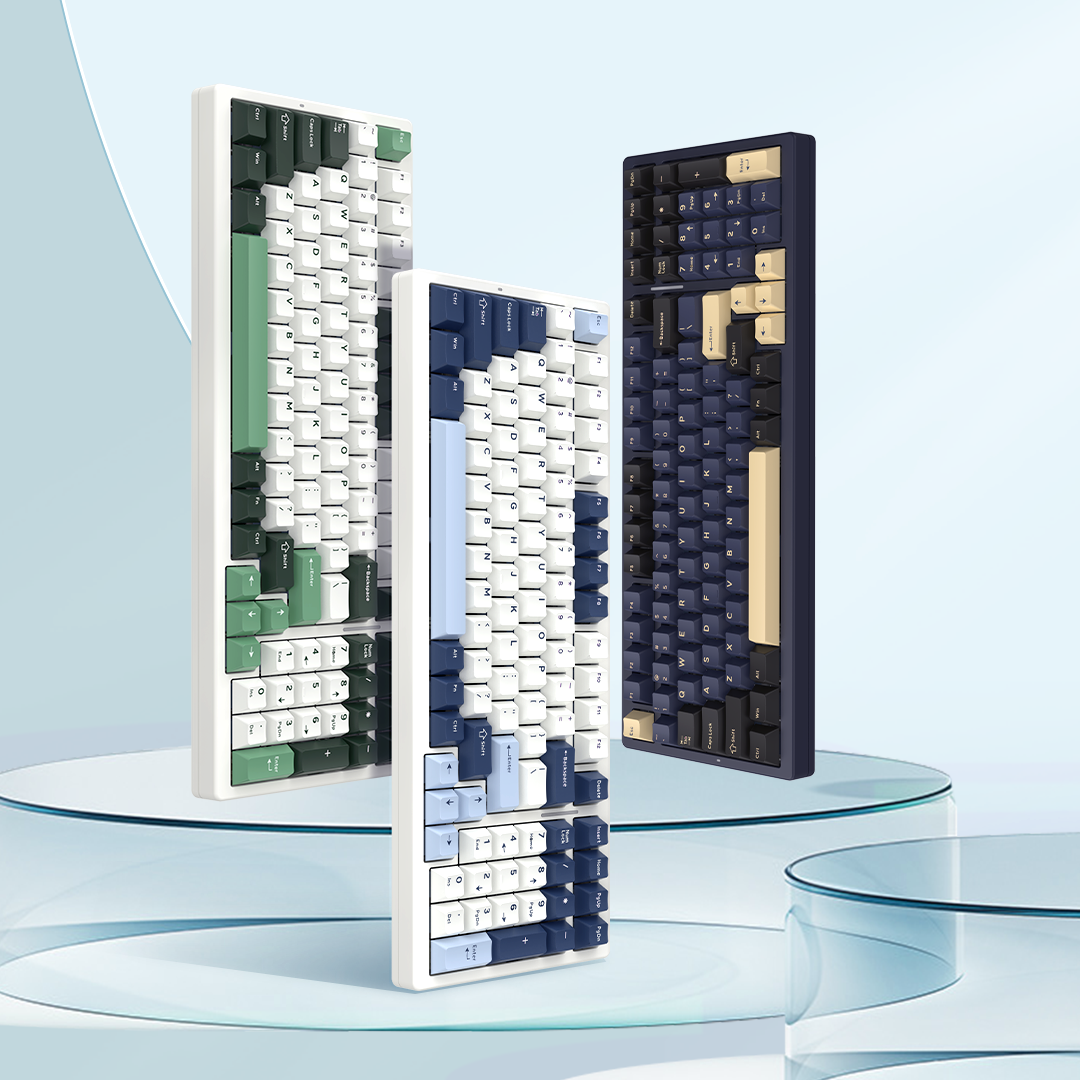Magnetic Switch Keyboard? What Kind of Keyboard is That?
In competitive gaming, where split-second reactions matter, magnetic switch keyboards are revolutionizing setups—even pros like Shroud favor them for titles like Valorant. These keyboards, quickly emerging as contenders for best gaming keyboards, borrow aerospace-grade Hall effect technology to deliver contactless keystrokes, solving age-old issues like latency, wear, and limited customization.
Ditching mechanical (physical wear) and optical (interference-prone) designs, magnetic switches offer adjustable actuation, ultra-fast response, and near-indestructible durability. This guide breaks down their tech, competitive edge, and how to choose the right one for your gameplay. Level up your setup—let’s explore why magnetic switches are gaming’s new standard.

How Magnetic Switches Work
Magnetic switches operate on Hall effect technology, refined for gaming precision after its 1879 discovery. Here’s how they outperform even the best mechanical keyboard designs:
1. Core Components: Magnet + Hall Effect Sensor
Neodymium Magnet: Embedded in each keycap stem, this powerful rare-earth magnet generates a stable magnetic field. Its strength (measured in gauss) and positioning are calibrated to work seamlessly with the sensor below.
Hall Effect Sensor: A microchip mounted on the PCB detects changes in magnetic flux. Unlike mechanical contacts or optical LEDs, it has no moving parts—just a semiconductor layer that converts magnetic fields into voltage signals.

2. Contactless Actuation: The 3-Step Process
Step 1: Key Press Initiates MovementWhen you press a key, the magnet descends toward the sensor. The distance between them decreases, altering the magnetic flux density detected by the sensor.
Step 2: Signal Generation via Hall EffectThe sensor measures the flux change and outputs a voltage proportional to the magnet’s proximity (the Hall voltage). This analog signal is clean and interference-resistant, unlike mechanical switches prone to “debounce” noise or optical switches vulnerable to dust blocking beams.
Step 3: Customizable Actuation ThresholdMost magnetic keyboards include a digital signal processor (DSP) that lets you set a trigger threshold via software .

3. Why This Design Destroys Traditional Switches
No Physical Wear = Infinite LifespanMechanical switches rely on metal leaf contacts that oxidize or wear after 50–100 million keystrokes. Optical switches use LED/phototransistor pairs that degrade from light leakage. Magnetic switches? With zero physical contact, they’re rated for 10+ billion keystrokes—virtually indestructible, even for streamers who type 10 hours daily.
Ultra-Low Latency ChainThe signal path is lightning-fast: sensor → DSP → USB/2.4GHz wireless transmission. Premium models like the Wooting Two HE achieve 0.1ms latency—10x faster than standard mechanical switches (1–5ms)—critical for frame-perfect inputs in Rocket League or Street Fighter 6.
Analog-Level PrecisionUnlike binary “on/off” mechanical switches, magnetic systems offer proportional input (when paired with compatible software/games). For example, in racing sims like Assetto Corsa, a partially pressed key can mimic a gas pedal’s sensitivity, letting you feather throttle with millimetric control.

Why the Early Adoption of Magnetic Switches Won Out
1. The Competitive Edge: Milliseconds Matter in FPS Games
Traditional mechanical keyboards operate on a binary “all or nothing” system—a key is either pressed (actuated) or not, with fixed trigger points (e.g., 2mm for Cherry MX Red). Magnetic switches shatter this limitation with adjustable actuation depth (0.1–4.0mm) and 0.1ms latency—10x faster than even the best mechanical switches (1–5ms). For FPS players, this means:
Instantaneous bullet registration in Valorant: When peeking around a corner in Bind, a 0.5mm actuation setting lets you tap “fire” the nanosecond your crosshair hits an enemy, outpacing opponents on mechanical switches.
Rapid-fire dominance in CS:GO: In a spray battle on Dust II, magnetic switches register 10+ shots per second without ghosting, compared to 6–8 on standard keyboards—critical for melting armor before your opponent reacts.Pro players like Sentinels’ TenZ admit: “Once you feel the zero-lag response, going back to mechanical feels like playing with a delay.”
2. Case Study: Wooting’s Rapid Trigger Revolution in Valorant
Wooting, a pioneer in magnetic switch tech, unlocked a game-changing feature for Valorant: dynamic actuation via their “Rapid Trigger” mode. Here’s how it works in practice:
Adjust on the fly for abilities: During a Phoenix “Run It Back” dash, set a deep 3.0mm actuation to avoid accidental activation while moving. When dropping a “Hot Hands” molly, switch to a 1.0mm trigger for instant deployment.
No more “double-tap” failures: In Valorant’s tight 1v1 duels, mechanical switches sometimes fail to register quick back-to-back clicks (due to debounce delay), but Wooting’s contactless design captures every input, even at 20 clicks per second.The result? Early adopters using Wooting keyboards saw a 15–20% improvement in first-shot accuracy and faster spike plant/defuse times in pro playtesting. As esports analyst Thooorin noted: “Magnetic switches aren’t just a trend—they’re a competitive necessity for FPS titles.”
Early adopters aren’t just winning games; they’re future-proofing their setups. As esports continues to demand pixel-perfect precision, magnetic switches have proven they’re not a niche tech—they’re the new baseline for competitive play. Ready to gain the same advantage? Let’s dive into how to choose your first magnetic switch keyboard.

How to Choose a Magnetic Switch Keyboard
Ready to experience magnetic tech? Here’s your guide, with a spotlight on the VGN A75 ($59.99)—the most affordable entry to best gaming keyboards with magnetic switches.
1. Start with Your Budget (No $200+ Needed)
Magnetic keyboards don’t require a premium price tag. The VGN A75 leads the pack at $59.99—more cheaper than rivals—delivering core Hall effect tech without compromises, It outperforms many budget mechanical models, offering performance that rivals even the best mechanical keyboard options at twice the price:
Adjustable actuation (0.1–4.0mm) for FPS/MMO precision
10+ billion keystroke lifespan (no physical wear)
Skip overpriced models—this is the lowest threshold to test magnetic switches.
2. Key Features for Gamers
Adjustable Trigger Depth: Customize actuation via software (e.g., 0.5mm for instant Valorant shots, 3.0mm for safe Minecraft builds).
Layout: The A75’s 75% design balances portability for desk space and travel.

Ready to Switch for Less?
Don’t wait—experience magnetic switches’ ultra-fast, customizable control starting at $59.99 with the VGN A75. Shop now and upgrade your gameplay without draining your wallet.










